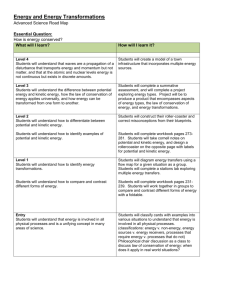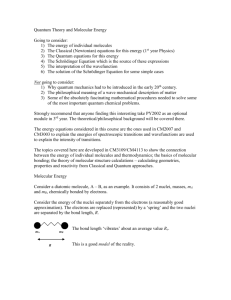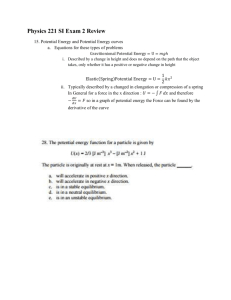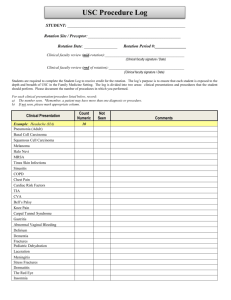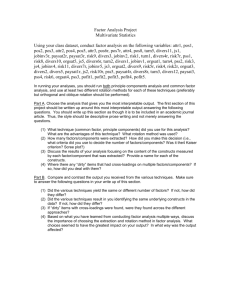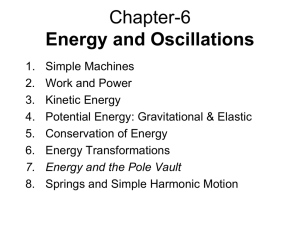Introduction to Energy Powerpoint
advertisement
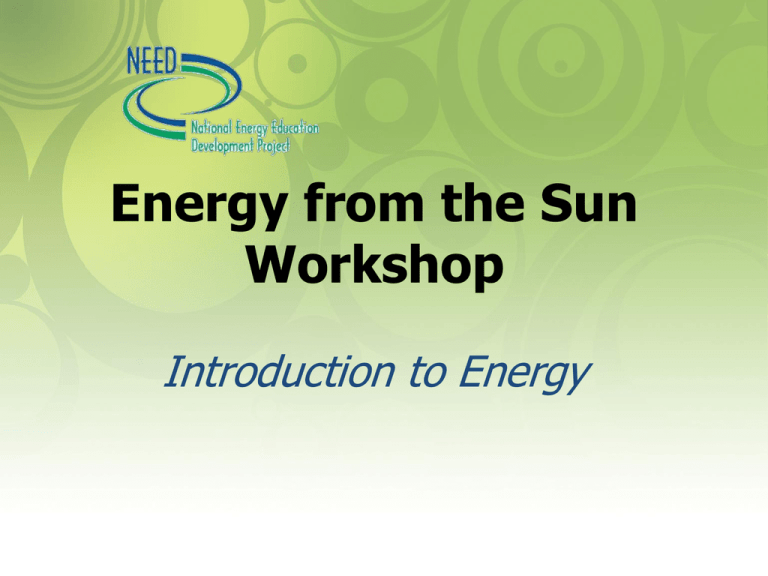
Energy from the Sun Workshop Introduction to Energy A NEED Energy Unit • 8 Steps 1. 2. 3. 4. 5. Science of Energy Sources of Energy Electricity Transportation Efficiency and Conservation 6. Enrichment and Reinforcement 7. Evaluation 8. Recognition • Easily Adaptable • Statistics updated annually • Curriculum units updated on rotating, periodic basis What is Energy? • “The ability to do work” • Causes changes • Two forms Potential Kinetic Potential Energy Gravitational Energy The energy an object or substance has because of its position; anything “up high” Potential Energy Stored Mechanical Energy Energy stored in an object by the application of force Must push or pull on an object Potential Energy Nuclear Energy Energy stored in the nucleus of the atom Holds the nucleus together Potential Energy Chemical Energy Energy stored in the bonds between atoms Holds molecules together Kinetic Energy Mechanical Energy (Motion) Movement of objects or substances from one place to another Kinetic Energy Electrical Energy Movement of electrons in one direction NOT AN ELECTRON PARADE! Kinetic Energy Sound Energy Movement of energy through substances in the form of longitudinal (compression) waves Kinetic Energy Radiant Energy Electromagnetic energy that travels in transverse waves Kinetic Energy Thermal Energy (a.k.a. Heat) Internal energy of a substance due to the vibration of atoms and molecules making up the substance Science of Energy Why study the Science of Energy? • Develop understanding of the science behind energy usage • NEED kit allows hands-on learning • Kids teaching kids. First they learn their own station and then teach it to their classmates (Jigsaw). How Does Science of Energy Work? • Teacher demonstration • Six student lab stations • Step-by-step teacher guides with background information. • Emphasis is placed on observations, measurements and comparisons. Objectives • Explain what energy enables us to do. • Differentiate between forms and sources of energy. • Demonstrate how energy is stored in the major energy sources. • Describe the main forms of energy and give examples. • Explain energy transformations. • Trace the flow of an energy system. Energy Transfers • Energy can not be created nor destroyed, only changed. o Law of Conservation of Energy o First Law of Thermodynamics • Energy will always transfer from high to low. • No energy transfer is 100% efficient. Before After Change XXoc XXXoc xoc YYoc YYYoc yoc First Rotation Second Rotation Third Rotation Fourth Rotation Fifth Rotation Sixth Rotation Describe the Energy Transformations Striking a match Photovoltaic cell Photosynthesis Movement of the Gulf Stream • Interior temperature increase of a car • • • • Transition: Forms to Sources •Forms - How Scientists Classify Energy •Sources - Where We Get the Energy To Make Our Lives More Comfortable, Convenient, & Productive chemical chemical chemical nuclear chemical chemical motion motion thermal radiant Transition: Forms to Sources •Forms - How Scientists Classify Energy •Sources - Where We Get the Energy To Make Our Lives More Comfortable, Convenient, & Productive 87.55% 8.62% 3.50% 0.22% 0.11% 8.22% 91.78% For More Information If you have questions, we have answers: • www.need.org – our website • info@need.org – questions about NEED • cturrel@need.org – questions about this workshop • 1-800-875-5029 – NEED main office phone number


